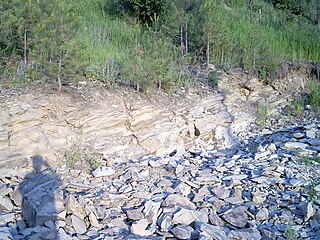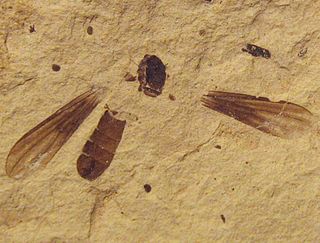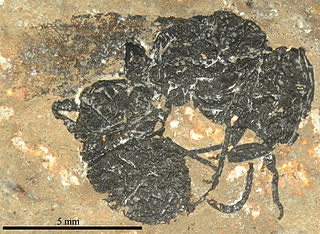
Pamphiliidae is a small wasp family within Symphyta, containing some 200 species from the temperate regions of North America and Eurasia. The larvae feed on plants, using silk to build webs or tents, or to roll leaves into tubes in which they feed, thus earning them the common names leaf-rolling sawflies or web-spinning sawflies. Some species are gregarious and the larvae live in large groups. Fossils of Pamphiliidae have been dated to the Jurassic period.
Microberotha is an extinct monotypic genus of "beaded lacewing" in the family Berothidae known from a fossil found in North America. When described the genus contained a single Ypresian-age species Microberotha macculloughi.
Dinopanorpa is an extinct monotypic genus of scorpionfly that contains the single species Dinopanorpa megarche and is the type genus of the extinct family Dinopanorpidae. The genus is known from a single hindwing specimen, the holotype, currently deposited in the collections of the National Museum of Natural History, as number "69173", and which was first described by Dr Theodore D.A. Cockerell in 1924. The name is a combination of the Greek deino meaning "terrible" or "monstrous" and "Panorpa", the type genus of Panorpidae the family in which Dinopanorpa was first placed.

The Klondike Mountain Formation is an Early Eocene (Ypresian) geological formation located in the northeast central area of Washington state. The formation, named for the type location designated in 1962, Klondike Mountain north of Republic, Washington, is composed of volcanic rocks in the upper unit and volcanics plus lacustrine (lakebed) sedimentation in which a lagerstätte with exceptionally well-preserved plant and insect fossils has been found, along with fossil epithermal hot springs.

Ypresiomyrma is an extinct genus of ants in the subfamily Myrmeciinae that was described in 2006. There are four species described; one species is from the Isle of Fur in Denmark, two are from the McAbee Fossil Beds in British Columbia, Canada, and the fourth from the Bol’shaya Svetlovodnaya fossil site in Russia. The queens of this genus are large, the mandibles are elongated and the eyes are well developed; a stinger is also present. The behaviour of these ants would have been similar to that of extant Myrmeciinae ants, such as solitary foraging for arthropod prey and never leaving pheromone trails. The alates were poor flyers due to their size, and birds and animals most likely preyed on these ants. Ypresiomyrma is not assigned to any tribe, and is instead generally regarded as incertae sedis within Myrmeciinae. However, some authors believe Ypresiomyrma should be assigned as incertae sedis within Formicidae.

Myrmeciites is an extinct form genus of bulldog ants in the subfamily Myrmeciinae of the family Formicidae, which contains three described species and two fossils not placed beyond the genus level. Described in 2006 from Ypresian stage deposits, all three of the described species and one unplaced fossil are from British Columbia, Canada, while the second unplaced fossil is from Washington State, USA. These ants were large, with the largest specimens collected reaching 3 centimetres (1.2 in). The behaviour of these ants would have been similar to extant Myrmeciinae ants, such as solitary foraging, nesting either in the soil or trees, and leaving no pheromone trail to food sources. Due to the poor preservation of these ants, their phylogenetic position among Myrmeciinae is unclear, and no type species has been designated. These ants are classified as incertae sedis in Myrmeciinae, but some writers have classified it as incertae sedis within the insect order Hymenoptera. This reclassification, however, has not been accepted; instead, Myrmeciites remains in Myrmeciinae.
Protostephanus is an extinct genus of crown wasp in the Hymenoptera family Stephanidae known from an Eocene fossil found in the United States of America. The genus contains a single described species, Protostephanus ashmeadi placed in the stephanid subfamily Stephaninae.

Brownimecia is an extinct genus of ants, the only genus in the tribe Brownimeciini and subfamily Brownimeciinae of the Formicidae. Fossils of the single identified species, Brownimecia clavata, are known from the Middle Cretaceous of North America. The genus is one of several ants described from Middle Cretaceous ambers of New Jersey. Brownimecia was initially placed in the subfamily Ponerinae, until it was transferred to its own subfamily in 2003; it can be distinguished from other ants due to its unusual sickle-like mandibles and other morphological features that makes this ant unique among the Formicidae. The ant is also small, measuring 3.43 millimetres (0.135 in), and a stinger is present in almost all of the specimens collected. The morphology of the mandibles suggest a high level of feeding specialization.
Aphaenogaster longaeva is an extinct species of ant in formicid subfamily Myrmicinae known from a solitary Eocene or Oligocene fossil found in North America. A. longaeva was one of five insect species described by the paleoentomologist Samuel Hubbard Scudder in an 1877 paper.

Archimyrmex is an extinct genus of ant in the formicid subfamily Myrmeciinae, described by palaeoentomologist Theodore Cockerell in 1923. The genus contains four described species, Archimyrmex rostratus, Archimyrmex piatnitzkyi, Archimyrmex smekali and Archimyrmex wedmannae. Archimyrmex is known from a group of Middle Eocene fossils which were found in North America, South America, and Europe. The genus was initially placed in the subfamily Ponerinae, but it was later placed in Myrmeciinae; it is now believed to be the ancestor of the extant primitive genus Myrmecia from Australia. Despite this, Archimyrmex is not a member to any tribe and is regarded as incertae sedis within Myrmeciinae. However, some authors believe Archimyrmex should be assigned as incertae sedis within Formicidae. These ants can be characterised by their large mandibles and body length, ranging from 13.2 to 30 mm. They also have long, thin legs and an elongated mesosoma (thorax) and petiole.

Metanephrocerus is an extinct genus of big-headed flies in the dipteran subfamily Protonephrocerinae, for which it is one of only two genera. The genus contains four described species, Metanephrocerus belgardeae, M. collini, M. groehni, and M. hoffeinsorum. Metanephrocerus is known from a group of Middle Eocene fossils which were found in Europe and a single early Eocene fossil from North America.

Emplastus is an extinct morphogenus of ants in the subfamily Dolichoderinae, known from fossils found in Asia and Europe. The genus contains twelve species described from sites in England, Eastern Europe and Far Eastern Russia.

Usomyrma is an extinct genus of ant in the formicid subfamily Dolichoderinae. The genus contains a single described species, Usomyrma mirabilis, that is known from two Middle Eocene fossils which were found in Scandinavian amber in Denmark.

Casaleia is an extinct genus of ants in the formicid subfamily Amblyoponinae described by Pagliano & Scaramozzino in 1990 from fossils found in Europe. The genus contains four species dating from the Eocene to Miocene, Casaleia eocenica, Casaleia inversa, Casaleia longiventris, Casaleia orientalis.
Eoprephasma is an extinct genus of stick insect in the superfamily Susumanioidea known from a group of Eocene fossils found in North America. When first described there was a single named species, E. hichensi.
Cretomerobius is an extinct genus of lacewings in the neuropteran family Hemerobiidae known from fossils found in Asia. The genus currently contains a single species, the Aptian C. disjunctus.
Holcorpa is a genus of extinct insects in the scorpionfly order Mecoptera. Two Eocene age species found in Western North America were placed into the genus, H. dillhoffi and H. maculosa.

Pachycondyla? messeliana is an extinct species of ants in the formicid subfamily Ponerinae described by from a fossil found in Europe. P.? messeliana is one of six Lutetian Pachycondyla species.
Ypresiosirex is an extinct genus of sawfly in the horntail family Siricidae. The genus is solely known from a single Eocene fossil found in North America. At the time of its description the new genus was composed of a single species named Ypresiosirex orthosemos.
Cuspilongus is an extinct genus of parasitic wasp in the sawfly family Cephidae. At the time of its description the new genus was comprised of a single species named Cuspilongus cachecreekensis, known from an Eocene fossil found in North America. Subsequently, Kopylov & Rasnitsyn (2016) transferred the Early Cretaceous (Aptian) species Mesocephus ghilarovi Rasnitsyn (1988), known from the Bon-Tsagan locality in Mongolia, to the genus Cuspilongus as well.










